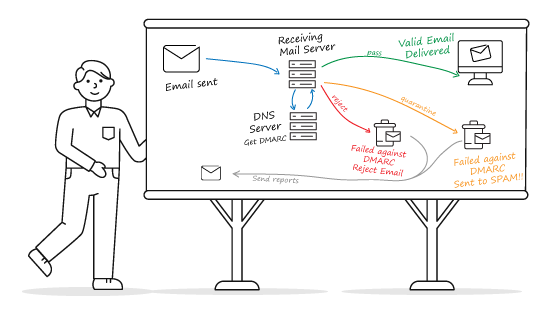Problem
What is DMARC?
What is the purpose of DMARC?
Is DMARC important?
What happens when an email is received?
Solution
Grab a coffee, as this knowledge base article is going to cover a few common questions about DMARC.

What is DMARC?
DMARC stands for Domain-based Message Authentication, Reporting, and Conformance. It is an email authentication protocol that uses DNS (Domain Name Service) records to give email receivers a way to verify the authenticity of emails they receive from a particular domain. DMARC builds on two existing email authentication protocols, Sender Policy Framework (SPF) and DomainKeys Identified Mail (DKIM), to provide a more comprehensive solution.
What is the purpose of DMARC?
Email is a part of our everyday lives, with billions of emails sent every day. Unfortunately, email is also a favourite tool of cybercriminals, who use it to send unsolicited emails and spread spam, phishing attacks and malware.
DMARC is a tool that helps protect email users from these malicious activities.
By publishing a DMARC policy, a domain owner can specify which email messages are legitimate and which should be rejected or quarantined. DMARC also provides detailed reporting capabilities, allowing domain owners to monitor the use of their domain and take action against senders who abuse it. By preventing email phishing attacks, spoofing, and malware infections, DMARC helps ensure the integrity and security of email communications.
Is DMARC important?
Some of the benefits of DMARC are :-
- Helps to prevent email phishing attacks. Phishing is a technique that cybercriminals use to trick users into revealing sensitive information such as passwords, credit card numbers, or personal data. DMARC ensures that emails are authentic and that they come from a legitimate source, reducing the risk of phishing attacks.
- Helps prevent email spoofing. Spoofing is when a cybercriminal sends an email that appears to come from a legitimate source, but is actually fraudulent. DMARC enables email receivers to verify that an email is authentic and to reject emails that fail to meet the specified authentication requirements.
- Protect email users from malware. Cybercriminals often use email to spread malware, such as viruses or Trojan horses. By verifying the authenticity of emails, DMARC helps reduce the risk of malware infections.
What happens when an email is received?
DMARC (Domain-based Message Authentication, Reporting, and Conformance) is an email authentication protocol that helps protect email users from spam, phishing attacks, and other malicious activities. DMARC uses a combination of two existing email authentication protocols, Sender Policy Framework (SPF) and DomainKeys Identified Mail (DKIM), to verify the authenticity of emails sent from a particular domain.
Below, we will explain how the DMARC process works when a user receives an email.
When an email is received, the email server checks for the existence of a DMARC record in the DNS (Domain Name System) records of the sender's domain. If a DMARC record is found, the email server will use it to determine how to handle the email.
The DMARC record specifies the authentication mechanisms that are used to verify the authenticity of emails sent from the domain. These mechanisms can include SPF, DKIM, or both. SPF checks whether the IP address of the sender is authorized to send emails from the domain, while DKIM uses a digital signature to verify the authenticity of the email.
If the email fails to meet the authentication requirements specified in the DMARC record, the email server will either reject or quarantine the email based on the policy specified in the DMARC record.
If the policy is set to reject, the email will be rejected by the email server and will not be delivered to the recipient's inbox. If the policy is set to quarantine, the email will be delivered to the recipient's spam or junk folder.
In addition to specifying a policy, the DMARC record can also include a reporting mechanism. The reporting mechanism allows the domain owner to receive detailed reports about the use of their domain, including information about emails that passed or failed authentication checks.
By checking DMARC on their email servers, email recipients can be confident that emails they receive are authentic and come from a legitimate source. DMARC provides a powerful tool to help prevent email phishing attacks, spoofing, and malware infections.
By implementing DMARC records in their DNS domains, email domain owners can protect their users from the risks associated with fraudulent emails and maintain the integrity of their brand.


